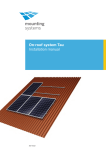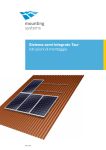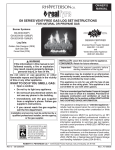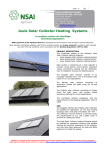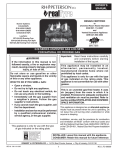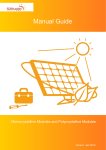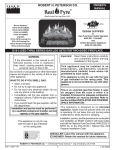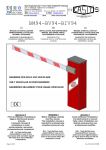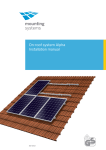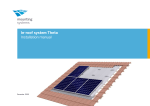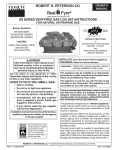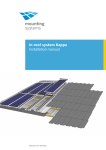Download Tau+ On-Roof System Installation Manual
Transcript
Tau+ On-Roof System Installation Manual 810-0107 Contents Tau + Installation Manual Tau + — The innovative trapezoidal solution with a plus 1.Introduction 1.1. Short Description 1.2. About These Instructions 1.3.Warnings 1.4.Safety 2 2 2 3 3 2. Technical Description 2.1. System Overview 2.2.Components 2.3. Technical Data 4 4 5 6 3. 3.1. 3.2. 3.3. 3.4. Important Mounting Information Conditions of Use Mounting Preparations Mounting Aids and Required Tools On the Mounting Descriptions 7 7 7 7 7 4. Planning the Module Area for a Portrait Layout of the Modules 8 5. Mounting Profile Rails for Portrait Mounting of the Modules 5.1. Placing the EPDMs 5.2. Positioning and Alignment of the Profile Rails 5.3. Placing the Side Trapezoid Clamp 5.4. Placing the Top Trapezoid Clamp 5.5. Fastening the Profile Rail 5.6. Connecting Profile Rails 5.7. Securing the Profile Rails From Excessive Slipping 2 Tau+-MA-ENG-1309 10 10 11 12 12 13 14 15 Mounting Modules in portrait orientation Mounting Clickstones Fastening the Modules on the Outer Side Fastening the Modules on the Inner Side Fastening Additional Module Rows 16 16 18 19 20 7. Planning the Module Area for Landscape Mounting of the Modules 21 8. Mounting of Profile Rails for Landscape Mounting of the Modules 22 9. 9.1. 9.2. 9.3. 9.4. Mounting Modules Laterally Mounting Clickstones Fastening the Modules on the Outer Side Fastening the Modules on the Inner Side Fastening Additional Module Rows 24 24 26 28 29 Tau + Installation Manual 6. 6.1. 6.2. 6.3. 6.4. Contents 1 1 1. Introduction Tau + Installation Manual 1.1. Short Description The Tau+ on-roof system is a robust racking system for the mounting of PV modules on trapezoidal sheet roofs. It consists of aluminium support rails and all necessary small parts for the fastening of the modules on to the rails as well as for the connection of the components with each other. The Tau+ allows for both portrait and landscape installation of the modules. It is crucial to carefully read these Mounting Instructions as well as all applicable documents prior to carrying out any installation, maintenance or disassembly work. You are provided with all the information required for the safe and complete mounting, maintenance and disassembly. Should you have any questions, please contact Mounting System GmbH. User Group Mounting Systems GmbH’s installation instructions are intended for the following persons (user group): 1.2. About These Instructions Content These instructions describe the installation of the onroof system Tau+ and all system-specific information for planning, components and safety. The drawings in the first part of the instructions show the portrait installation of framed modules. The landscape version is treated separately from chapter 7 onwards. Applicable Documents In addition to this document, the document “Mounting Instructions for PV Mounting Systems: General Part” is part of each product delivery. This document describes the general applicable information for Mounting Systems’ product range on standardisation, safety, transport, maintenance, disassembly and disposal. Both the present Mounting Instructions and the “Mounting Instructions for PV Mounting Systems: General Part” are an integral part of the mounting system Tau+ and must be adhered to for each installation. • Skilled personnel • Instructed personnel Skilled personnel Skilled personnel are individuals who, on the basis of their professional training, are able to execute installation, maintenance, and disassembly work appropriately. Instructed personnel Instructed personnel are individuals who have been instructed and taught appropriately regarding the assigned tasks and the possible risks in the event of improper conduct. An instructed individual must have received instructions regarding the required safety policies, precautions, relevant regulations, accident prevention regulations, as well as operating conditions and must have demonstrated his/her competence. The implemented work must be approved by skilled personnel. Orientation Guide The following visual aids will make installation easier. Pictograms: This symbol indicates important information and useful tips. i This symbol indicates tips and tricks to make processes easier. 2 Introduction 1.4. Safety The warnings used in these Mounting Instructions indicate safety-related information. They include: All generally applicable safety regulations for products of Mounting System GmbH can be viewed in the document “Installation Instructions for PV Mounting Systems: General Part.” Please read this document carefully and adhere to the instructions - only use the system for its intended purpose, comply with the obligations of the building owner and follow both the general and specific safety instructions. In addition, in all actions you carry out please observe the specific safety instructions, which precede the process steps in the present mounting instructions. • Warning symbols (pictograms) • Signal words for the identification of the hazard level • Information about the type and source of the hazard • Information about potential consequences in case of the hazard being disregarded • Measures for the prevention of hazards and the prevention of injuries or damage to property. Tau + Installation Manual 1.3. Warnings The signal words of the warnings respectively indicate one of the following hazard levels: DANGER WARNING CAUTION ATTENTION Indicates a great and extraordinary danger, which may result in death or serious injury if ignored. Indicates a potentially dangerous situation, which may result to serious or medium injury or damage to the property. Indicates a potentially dangerous situation, which may result in minor injuries or damage to the property if ignored. Indicates potential danger, which can result in damage to the property. Introduction 3 2. Technical Description The design of the individual system components can vary. This depends on: 2.1. System Overview • Roof type, • Type of module, • Number of modules and configuration • Local conditions. Tau+ Installation Manual In the following, all system components are described. a e c d b Image 2.1. – 1 a Roof b Lateral fixing clip c Module clamp d Module end clamp eEPDM 4 Technical Description 2.2. Components In the following all system components of the Tau+ are shown, which can be included in the scope of the delivery. The exact scope of the delivery and the number of individual components depends on your order. a b c a Tau+ Rail Tau+ Installation Manual b Tau+ Rail for landscape installation, with pre-mounted EPDM c Tau+ side fixing clip with AluFix seal d Tau+ top fixing clip d e f e Thin sheet-metal screw (5.5x25mm) f Tau+ Connector i g Tau+ Connector with grounding option h EPDM 80 mm (for top fixing clip) or 40 mm (for side fixing clip) g h i i Module clamp j Module end clamp k Position lock j k Image 2.2. – 1 Technical Description 5 Tau+ Installation Manual 2.3. Technical Data Application Pitched roof – on-roof Roof cladding Suitable for most types of roof cladding Roof slope Up to 60° Building height Up to 20 m PV modules Framed Module orientation Landscape, portrait Size of module array Any size possible Position of the module array No special requirements Distance between roof fixing points Up to 2m Standards Eurocode 1 – Action on structures Eurocode 9 – Design of aluminium structures Supporting profiles Extruded Aluminium (EN AW 6063 T66) Hooks, small parts Stainless steel (V2A) Colour Aluminium: plate finish; on request: Visible components available in back Warranty 10 Years 1 1 2 1 3 1 Different maximum values may apply, depending on site, building, choice of roof fixations and module type. Using the Tau+ calculation tool, you can have the exact values for your specific project calculated quickly and easily. 2 Due to thermal expansion of the material, we recommend an interruption of the array after 12 m. 3 Please find the exact terms in the Mounting Systems GmbH warranty document. 6 Technical Description 3.1 Conditions of Use The Tau+ on-roof system is designed with different rail and roof fasteners in accordance with Eurocode 1-DIN EN 1991-1-1 for various maximum loads. The suitability of the material must therefore be verified for each system, e.g. by means of the Tau+ configuration tool. Please also observe the suitability constraints, which are listed in Chapter 2.3 “Technical Data”. 3.2. Mounting Preparations Mounting System GmbH recommends that you inquire about the local conditions before ordering the Tau+. In particular, acquaint yourself with: • Roof condition (e.g. bead distance and bead height), • The thickness and the material of the trapezoidal sheet, • The quality and the condition of the trapezoidal sheet • Adequate fastening of the trapezoidal sheet to the substructure. 3.3. Mounting Aids and Required Tools Risk of fatal injury from damage to roof DANGER Excessive loads can severely damage the roof. • Before mounting and installation, please make sure that the building and especially the roof cladding meet the increased structural requirements for the PV system and the mounting operation. For the installation of the mounting system, you will require the following tools: • Allen key 5 mm/ hexagon socket drill bit, 5mm, • Cordless screwdriver • Drill bit for cordless screwdriver TX30 • Angle grinder with metal cutting disc • Chalk line • Spirit level • Yard stick / tape measure • Lifting gear (e.g. aerial lifts, carrying straps) • Suction lifter • If required, Spacer gauge (for landscape installation) 3.4. On the Mounting Descriptions Risk of fatal injury from falling objects DANGER Parts falling from the roof can result in serious injuries or death. • Before commencing with the installation, please ensure that the material used meets the structural requirements of the site. In the following chapters all steps for the planning and installation of the Tau+ are listed in the correct sequence. Chapters 4, 5 and 6 describe the installation steps for a portrait layout of the modules; chapters 7, 8 and 9 describe the installation steps for a landscape installation. Please adhere to the mounting steps listed here and be sure to follow the safety instructions. Important Installation Information 7 Tau+ Installation Manual 3. Important Installation Information Tau + Installation Manual 4.Planning the Module Area for a Portrait Layout of the Modules For portrait installation, the profile rails are fastened to the beads of the trapezoidal sheet by means of fixing clips. The clips must be mounted with a defined distance, which depends on the material and thickness of the trapezoidal sheet, the distance to the high beads, the position on the roof and the onsite conditions.* The layout is defined by the design in the configuration tool or by project-related structural analyses. Taking the above mentioned points into account, the fixing clips must be placed in such a way that they are as close as possible to the module clamps. Risk of fatal injury from damage to roof DANGER Excessive loads can severely damage the roof. • Before mounting and installation, please make sure that the building and especially the roof construction meets the increased structural requirements resulting from the PV system and the assembly operation. When positioning the fixing clips take into account that: • The specified dimensions are approximate values • The dimensions of the trapezoidal sheet and the high beads define the true horizontal distance. Risk of fatal injury from falling objects DANGER * Layout required according to local conditions in accordance with Eurocode 1-DIN EN 1991-1-1/Eurocode 9-DIN EN 1999-1-1. 8 Planning the Module Area for a Portrait Layout of the Modules Parts falling from the roof can result in serious injuries or death. • Before any mounting or installation, please make sure that the material used is suitable for the building structure and meets the structural requirements applicable on-site. 2 5 Tau + Installation Manual 3 1 4 Image 4. – 1 1 Height of the module field: Number of modules vertically x module length (+ desired clearances) 2 Width of the module field: Number of modules horizontally x (module width + 19 mm) + 41 mm 3 Vertical distance of the rail (in accordance with the clamping points defined by the module manufacturer): Approx. quarter points of the modules = 1/2 x module length 4 Horizontal distance of the fixing clips: According to the plan, depending on the trapezoidal sheet and the structural calculations* 5 Distance between the modules = 17-19 mm * Layout required according to local conditions in accordance with Eurocode 1-DIN EN 1991-1-1/Eurocode 9-DIN EN 1999-1-1. Planning the Module Area for a Portrait Layout of the Modules 9 5.Installing Rails for Portrait Layout of the Modules Risk of fatal injury from falling objects Risk of fatal injury due to falling DANGER Falling from the roof can result in serious injuries or death. Tau + Installation Manual • Please wear the statutory protective equipment. • Secure yourself against falling. • Do not perform any work in strong winds. DANGER Parts falling from the roof can result in serious injuries or death. • Block off the hazard area on the ground prior to the mounting work to prevent falling objects injuring persons. • Ensure that no parts can fall off the roof. • Please wear the statutory protective equipment. • Do not stay in the hazard area. • Do not perform any work in strong winds. • After completion of the installation, check the racking system and the modules for a tight fit. 5.1. Placing the EPDMs Mounting steps: • Determine the position of the rails on the trapezoidal sheet taking into account the permissible clamping points of the PV modules used. • Mark the position of the EPDMs on each high bead with the aid of a chalk line. Image 5.1. – 1 • Stick an EPDM strip onto each high bead on which the rails rest. • For the fixation of the rails with side fixing clips , EPDM 40x20x1 mm is used; for the top fixing clips, use EPDM 80x20x1 mm. Make sure that the rail is not positioned on callottes. The rail position might have to be adapted accordingly, taking the clamping area of the modules into account. Image 5.1. – 2 10 Installing Rails for Portrait Layout of the Modules 5.2. Positioning and Alignment of the Rails Mounting steps: • Position the total rail length and perform any necessary rail cuts. • Place the rails on the applied EPDMs. • Align the rails by using a chalk line or spirit level. i Note: Connected rail tracks should not exceed a length of 12 m. The total rail length required depends on the width of the module field (see Chapter 4). The permissible cantilever (overhanging of the loose rail ends over the last positioning on a high bead) is limited to a maximum of 17.5 cm. Do not exceed this limit. If necessary, cut rails accordingly or use connectors. Installing Rails for Portrait Layout of the Modules 11 Tau + Installation Manual Image 5.2. – 1 5.3. Placing the Side Fixing Clips Mounting steps: • Insert the side fixing clip in the side channel. Tau+ Installation Manual • Press the clip onto the side of the high bead and make sure that it makes even contact and that it is hooked in correctly in the side channel of the rail. • The side fixing clips are fastened to opposite sides of the high bead. Image 5.3. – 1 Material damage due to incorrect mounting CAUTION Incorrectly mounted fixing clips can pull out. • When inserting the fixing clips, always ensure the correct fit of the clip in the channel. Image 5.3. – 2 5.4. Placing the Top Fixing Clips Mounting steps: • Place the fixing clip from above on to the EPDM and the lateral fixing channel of the rail. • Place the opposite clip. Remember to use the longer EPDM pieces of 80x20x1 mm. Image 5.4. – 1 Material damage due to incorrect mounting CAUTION Incorrectly mounted fixing clips can pull out. • When inserting the fixing clips, always ensure the correct fit of the clamp in the rail channel. Image 5.4. – 2 12 Installing Rails for Portrait Layout of the Modules 5.5. Fastening the Rails Image 5.5. – 1 Mounting steps: • Fasten the fixing clips on the side or on the top with the supplied thin sheet-metal screws 5.5x25 mm with sealing washer. Make sure not to over tighten the screws. The appropriate tightening torque depends on the strength and the material of the trapezoidal sheet. Image 5.5. – 2 Damage to building from leaking CAUTION Image 5.5. – 3 Image 5.5. – 4 • Check that the fixing clips sit evenly on the high bead. • Make sure that the AluFix seal between the high bead and the clip has a clean fit. • When mounting the top fixing clips, make sure the EPDMs are set correctly. Damage to the building and the PV system due to incorrect mounting CAUTION Incorrect distance between the fixing clips can cause damage to the building and the PV system. • When fastening the fixing clips to the rails, make sure to adhere to the distances defined in the calculation tool or the projectspecific analysis. • Distinguish between and adhere to the possibly differing distances in the centre and at the edges of the roof. Incorrectly mounted fixing clips and thin sheet-metal screws can lead to leaks. Material damage due to incorrect mounting CAUTION Incorrectly mounted thin sheetmetal screws can pull out. • Fasten the thin sheet-metal screws tightly but do not overtighten. Installing Rails for Portrait Layout of the Modules 13 Tau+ Installation Manual i Note: Do not fasten all rails at once, but alternate between installation steps 5.5 and 5.6. Mount the individual rails, which have been connected with a connector. 5.6. Connecting Rails i Tau+ Installation Manual Image 6.1. – 1 Note: Rail connectors are provided for linking individual rails. There are two different types of connectors, with and without screws for a bonded connection between the rails. Mounting steps: • Insert the connector into the first rail. • Slide the next rail onto the placed connector. Image 6.1. – 2 • When using the rail connector with bonding option, tighten the two pre-mounted screws. i Image 6.1. – 3 Image 6.1. – 4 Image 6.1. – 5 Image 6.1. – 6 14 Installing the Base Rails Note: The connected rail tracks should not exceed a length of 12 m. Thereafter, an expansion joint (approx. 5 cm) must be considered. Do not install modules over the expansion joint. Image 5.7. – 1 The rails must be secured in their position. The clips used allow the rail to expand lengthwise, which would e.g. occur during fluctuation in temperature. In order to secure the position of the rails and still allow for expansion, a position lock is inserted at the side of the rail ends. Rows of rails which are connected with connectors only need to be secured once with two position locks. Individual rails must be provided with two position locks each. Mounting steps: • Place one lock at each end of a row of rails. • Keep a distance of approx. 2 cm to the last fixing clip. Image 5.7. – 2 Image 5.7. – 3 Installing Rails for Portrait Layout of the Modules 15 Tau + Installation Manual 5.7. Securing the Profile Rails against excessive lateral shift 6.Mounting Modules in portrait orientation Tau + Installation Manual The modules are mounted to the rails one by one. Mounting Systems GmbH recommends mounting the modules starting from one side. Module clamps and module end clamps are used for the fastening of the modules. The module end clamps can hold one module each. The module clamps are positioned between two modules. 6.1. Mounting Clickstones 1 2 Clickstones are used for the installation of the modules. The Clickstone is a special clip with which the module clamps are fastened to the rail. You only need an Allen key (5 mm) for the mounting. You can insert the Clickstone from above into the channel of the rail. Mounting steps: • Insert the Clickstone at a slight angle into the rail channel. • Push the Clickstone down. Make sure you hear the Clickstone clicking into the rail. i 3 4 Note: The shape of the Clickstone corresponds exactly to the profile of the rail channel. It has been consciously constructed not to run easily in order to prevent unintentional slipping for vertical rail tracks. To move the Clickstone, press lightly on the bolt, from above, and move the stone sideways by applying a little pressure. • Tighten the hexagon socket bolt with a torque of 8 Nm. Image 6.1. – 1 16 Mounting Modules in portrait orientation Material damage due to incorrect installation CAUTION Incorrectly mounted Clickstones can become loose; as a result, PV modules can fall and be damaged. • Mount all Clickstone connections in accordance with the instructions. Material damage caused by deformed Clickstones CAUTION If clearly deformed Clickstones are used, the safety of the module fastening is not guaranteed. PV modules can fall and be damaged. • Only use Clickstones where the lugs are parallel to each other and you can clearly hear them clicking into the rail channel. • Replace deformed Clickstones prior to installation. Image 6.1. – 2 Mounting Modules in portrait orientation 17 Tau + Installation Manual i Note: The lugs on the inside of the Clickstone are designed in such a way that once the bolt has been tightened, they prevent a “click out” mechanically. Accordingly, the bolt must first be unscrewed to above the lugs before the Clickstone can be removed from the rail by pressing the sides of the stone together and lifting. 6.2. Fastening the Modules on the Outer Side The margin modules of the PV system (for portrait mounting, the left and right module column) are fastened on the outer side with two module end clamps each. Tau+ Installation Manual Mounting steps: • Place and align an outer module. The rail must protrude the module by 30 mm. Image 6.2. – 1 • Insert the Clickstone of the module end clamp into the channel of the rail. • Push the module end clamp right to the module frame. • Tighten the bolt (torque 8 Nm) and thus clamp the module. Image 6.2. – 2 Material damage due to incorrect mounting CAUTION Image 6.2. – 3 18 Mounting Modules in portrait orientation Incorrectly fastened modules can fall and become damaged. • Make sure the Clickstones click in correctly. • Push the module end clamp all the way to the module. • Adhere to the stipulated torque when tightening the bolt. • Check the module fits tightly after mounting. 6.3. Fastening the Modules on the Inner Side Two module clamps are fastened between two modules. Mounting steps: • Push the module clamp all the way to the frame of the already mounted module. • Push the second module to the module clamp and align. Image 6.3. – 1 • Tighten the bolt (torque 8 Nm) and thus clamp the modules. Material damage due to incorrect mounting CAUTION Image 6.3. – 2 Incorrectly fastened modules can fall and become damaged. • Make sure the Clickstones click in correctly. • Push the module clamp all the way to the module. • Adhere to the stipulated torque when tightening the bolt. • Check the modules fits tightly after mounting. Image 6.3. – 3 Image 6.3. – 4 Image 6.3. – 5 Mounting Modules in portrait orientation 19 Tau + Installation Manual • Insert the Clickstone of the module clamp into the rail channel of the rail. 6.4. Fastening Additional Module Rows Mounting steps: Tau + Installation Manual • Push the modules in the upper rows from above down to the modules in the lower rows. For optical reasons you can also keep a distance to the lower module. Image 6.4. – 1 Note: Use e.g. a module clamp as a spacer gauge. This way you will achieve identical horizontal and verticaldistances between modules. • Fasten the modules analogously to the 1st row with module end clamps and module clamps (see 6.2. and 6.3.) Image 6.4. – 2 20 Mounting Modules in portrait orientation 7.Planning the Module Area for a Landscape Layout of the Modules Risk of fatal injury from damage to roof DANGER Excessive loads can severely damage the roof. • Before mounting and installation, please make sure that the building and especially the roof cladding meets the increased structural requirements for the PV system and the mounting operation. 3 7 Risk of fatal injury from falling objects 6 DANGER 1 4 Parts falling from the roof can result in serious injuries or death. • Before commencing with the installation, please ensure that the material used meets the structural requirements of the site. 5 2 Image 7. – 1 1 Height of the module field: Number of modules vertically x (module width + 19 mm) + 41 mm 2 Width of the module field: Number of modules horizontally x module length (+ desired clearances) 3 Module length 4 Module width 5 Vertical distance between two rail sections: Width of the module minus 82mm (clear distance between the rail pieces, tolerance + /-1mm) 6 Distance between the modules = 17-19 mm 7 Horizontal distance between the rail pieces of a module column: approx. 1/2 x module length, depending on the bead grid ( the rail pieces must be positioned on the high beads) Planning the Module Area for a Landscape Layout of the Modules 21 Tau+ Installation Manual For landscape installation, short rail pieces (GS 1/15 CS) of a length of 100 mm are installed. The distances are determined by the dimensions of the modules to be installed as well as the high bead distance. The clamping points stipulated by the module manufacturer must be adhered to. The distances between the rails are derived as follows: 8.Installing Rails for Landscape Layout of the Modules Tau + Installation Manual For landscape installation, rail pieces of a length of 100 mm (GS 1/15 CS) are installed. EPDM strips are pre-mounted and no longer need to be set. The rails are directly fastened to the high bead with two thin sheet-metal screws. Risk of fatal injury due to falling DANGER Falling from the roof can result in serious injuries or death. • Please wear the statutory protective equipment. • Secure yourself against falling. • Do not perform any work in strong winds. 22 Installing Rails for Landscape Layout of the Modules Risk of fatal injury from falling objects. DANGER Parts falling from the roof can result in serious injuries or death. • Block off the hazard area on the ground prior to the installation work to prevent falling objects injuring persons. • Make sure that no parts can fall off the roof. • Please wear the statutory protective equipment. • Do not stay in the hazard area. • Do not perform any work in strong winds. • After completion of the installation, check the mounting system and the modules for a tight fit. Mounting steps: 90° 90° 90° • Mark the position of the short rails on each high bead with the aid of a chalk line. Make sure that the chalk line has an angle of exactly 90° to the high beads. Image 8. – 1 90° • Start from the bottom with the first row and position the rail pieces precisely parallel to the beads on the high beads. • Fasten the profile rail pieces with two thin sheetmetal pieces each in the trapezoidal sheet. • Mount the further rows of rail pieces in the same manner. Make sure to keep the correct vertical distances between the rail pieces. Image 8. – 2 Material damage due to incorrect mounting CAUTION Image 8. – 3 Image 8. – 4 Incorrectly fastened thin sheetmetal screws can pull out. • Fasten the thin sheet-metal screws tightly but do not over tighten. Image 8. – 5 Installing Rails for Landscape Layout of the Modules 23 Tau + Installation Manual 90° • Determine the position of the rails on the trapezoidal sheet taking into account the high bead distance and the permitted clamping points of the PV modules used. 9.Mounting Modules in Landscape orientation Tau + Installation Manual The modules are mounted on the rails one by one. Mounting Systems GmbH recommends mounting the modules in columns from the bottom to the top. Module clamps and module end clamps are used for the fastening of the modules. The module end clamps can hold one module each. The module clamps are positioned between two modules. 9.1. Mounting Clickstones 1 2 Clickstones are used for the installation of the modules. The Clickstone is a special clip with which the module clamps are fastened in the profile rail. You only need an Allen key (5 mm) for the mounting. You can insert the Clickstone from above into the channel of the rail. Mounting steps: • Insert the Clickstone at a slight angle into the rail channel. • Push the Clickstone down. Make sure you hear the Clickstone clicking into the rail. 3 4 i Note: The shape of the Clickstone corresponds exactly to the profile of the rail channel. It has been consciously constructed not to run easily in order to prevent unintentional slipping for vertical rail tracks. To move the Clickstone, press lightly on the bolt, from above, and move the stone sideways by applying a little pressure.pressure. Image 9.1. – 1 • Tighten the hexagon socket bolt with a torque of 8 Nm. 24 Mounting Modules in Landscape orientation Material damage due to incorrect installation CAUTION Incorrectly mounted Clickstones can become loose; as a result, PV modules can fall and be damaged. • Mount all Clickstone connections in accordance with the instructions. Material damage caused by deformed Clickstones CAUTION If clearly deformed Clickstones are used, the safety of the module fastening is not guaranteed. PV modules can fall and be damaged. • Only use Clickstones where the lugs are parallel to each other and you can clearly hear them clicking into the rail channel. • Replace deformed Clickstones prior to installation. Image 9.1. – 2 Mounting Modules in Landscape orientation 25 Tau + Installation Manual i Note: The lugs on the inside of the Clickstone are designed in such a way that once the bolt has been tightened, they prevent a “click out” mechanically. Accordingly, the bolt must first be unscrewed to above the lugs before the Clickstone can be removed from the rail by pressing the sides of the stone together and lifting. 9.2. Fastening the Modules on the Outer Side The margin modules of the PV system (for landscape mounting, the top and bottom module row) are fastened on the outer side with two module end clamps each. Tau+ Installation Manual Mounting steps: • Insert the Clickstone of the module end clamp in the channel of the rail. Image 9.2. – 1 • Place and align the module. • Push the module end clamp right to the module frame. • Tighten the screw (torque 8 Nm) and thus clamp the module. Image 9.2. – 2 Image 9.2. – 3 Correct position of the module end clamp: Positioned so as to sit between the thin sheet-metal screws. Image 9.2. – 4 26 Mounting Modules in Landscape orientation Material damage due to incorrect mounting • Make sure the Clickstones click in correctly. • Push the module end clamp all the way to the module. • Adhere to the stipulated torque when tightening the screw. • Check the module fits tightly after mounting. Image 9.2. – 5 Image 9.2. – 6 Incorrectly fastened modules can fall and be damaged. Material damage due to incorrect mounting Image 9.2. – 7 CAUTION Overloaded thin sheet-metal screws can pull out. • Pay attention to correct positioning of the module end clamp. The Clickstone must be positioned between the two thin sheet-metal screws of the rail element. Image 9.2. – 8 Mounting Modules in Landscape orientation 27 Tau + Installation Manual CAUTION 9.3. Fastening the Modules on the Inner Side Two module clamps are fastened between two modules. Mounting steps: • Insert the Clickstone of the module clamp into the channel of the rail. Tau+ Installation Manual Image 9.3. – 1 • Push the module clamp all the way to the frame of the already mounted module. • Push the second module to the module clamp and align. • Tighten the screw (torque 8 Nm) and thus clamp the modules. Image 9.3. – 2 Image 9.3. – 3 Correct position of the module clamp: positioned so as to sit between the thin sheet-metal screws. Material damage due to incorrect mounting CAUTION Incorrectly fastened modules can fall and be damaged. • Make sure the Clickstones click in correctly. • Push the module clamp all the way to the module. • Adhere to the stipulated torque when tightening the screw. • Check the module fits tightly after mounting. Image 9.3. – 4 Material damage due to incorrect mounting CAUTION Image 9.3. – 5 Image 9.2. – 6 Overloaded thin sheet-metal screws can pull out. • Pay attention to correct positioning of the module clamp. The Clickstone must be positioned between the two thin sheetmetal screws of the rail element. Image 9.3. – 7 28 Mounting Modules in Landscape orientation 9.4. Fastening Additional Module Rows Mounting steps: i Image 9.4. – 1 Note: Use e.g. a module clamp as a distance gauge. This way you will achieve identical horizontal and vertical distances between the modules. • Fasten the modules analogously to the 1st column with module end clamps and module clamps (see 9.2 and 9.3). Image 9.4. – 2 Mounting Modules in Landscape orientation 29 Tau + Installation Manual • Slide the modules of the other columns sideways to the modules of the outer row. For optical reasons you can also keep a distance between the module columns. Mounting Systems GmbH Mittenwalder Straße 9a D 15834 Rangsdorf Tel. +49 (0) 33708 529-0 Fax +49 (0) 33708 529-199 [email protected] www.mounting-systems.com Subject to technical alterations 2013 © Mounting Systems GmbH
































